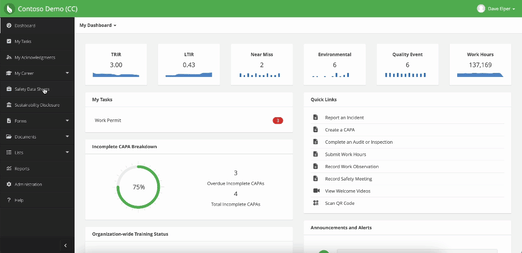Environmental, Health, and Safety (EHS) management is no longer an optional consideration for businesses. It’s a fundamental responsibility for organizations of all sizes and across all industries.
Effective EHS programs not only protect the well-being of employees but also ensure regulatory compliance, minimize operational risks, and contribute to a positive public image.
However, the specific needs and challenges associated with EHS management can vary greatly depending on the industry. A manufacturing facility grappling with hazardous chemicals and complex machinery will have vastly different EHS concerns compared to a healthcare provider focused on biohazard control and medication safety.
This reality highlights the limitations of generic EHS software solutions. A one-size-fits-all approach often fails to address the unique risk profiles and regulatory requirements of different sectors.
This article explores the significant advantages of implementing industry-specific EHS software solutions. We’ll talk about three key sectors – manufacturing, construction, and healthcare – to showcase how tailored software can empower organizations to achieve greater efficiency, enhance risk management, and ensure ongoing compliance with ever-evolving regulations. By embracing industry-specific EHS solutions, organizations can cultivate a safer and healthier work environment while fostering a culture of continuous improvement in EHS practices.

The Advantages of Tailored Solutions
Using a tailored solution for a specific industry offers myriad advantages for these specific sectors. Such advantages include:
- Targeted Functionality: Industry-specific software addresses the specific compliance needs and risk factors relevant to your industry. For example, construction management software might include modules for managing hazardous materials specific to construction sites, while healthcare EHS software might focus on tracking and managing medical waste disposal.
- Enhanced Efficiency: Streamlined workflows and pre-populated templates specific to your industry can significantly improve data collection, reporting, and overall EHS program efficiency.
- Improved Risk Management: Industry-specific software often incorporates industry best practices and risk management tools tailored to the unique hazards present in your workplace.
- Simplified Compliance: These solutions can help you stay up-to-date on relevant regulations and automate tasks like permit renewals and regulatory reporting.
Industry-Specific Examples
1. Manufacturing
- Focus Areas: Manufacturing facilities often deal with hazardous materials, complex machinery, and potential ergonomic risks. Workers might be exposed to chemicals, operate machinery with moving parts, or perform repetitive tasks that can lead to musculoskeletal disorders (MSDs).
- Software Features: Manufacturing EHS software might include modules for:
- Chemical Inventory Management: Track and manage Safety Data Sheets (SDS) electronically for all hazardous chemicals used on-site. This ensures compliance with hazard communication standards and simplifies access to critical safety information. Imagine a system that automatically alerts employees when an SDS needs to be updated based on the manufacturer’s latest revision.
- Machine Safety Protocols: Develop and manage digital lockout/tagout procedures, machine guarding protocols, and preventive maintenance schedules to minimize machine-related accidents. The software can also facilitate risk assessments for specific machinery, allowing for the identification and implementation of necessary safety controls.
- Ergonomic Assessments: Identify and address ergonomic risks associated with repetitive tasks or awkward postures through software-aided assessments and job design recommendations. The software might also provide guidance on proper lifting techniques and workstation ergonomics to prevent MSDs.
- Benefits: Streamlined processes for SDS management, incident reporting, and hazard communication training can significantly enhance safety in manufacturing environments.
- Imagine a system that automatically sends reminders for required hazard communication training based on the specific chemicals each worker handles, ensuring they are up-to-date on the safety protocols for the materials they work with. This can be particularly beneficial in facilities with a large and diverse chemical inventory.

2. Construction
- Focus Areas: Construction sites are inherently dynamic and pose risks like falls from height, exposure to dust and hazardous materials like asbestos or lead, and working with heavy machinery. Construction crews also face unique challenges related to constantly changing work environments and potential interactions with the public.
- Software Features: Construction EHS software might include modules for:
- Daily Safety Checklists: Create and utilize digital checklists tailored to specific tasks and work areas. These checklists can ensure daily safety inspections are conducted thoroughly, covering areas like fall protection (roofing, scaffolding, ladders), excavation safety, trench shoring, electrical safety, and fire prevention measures. The software can also track completion of checklists by individual workers and supervisors, providing a clear audit trail for safety compliance.
- Near Miss Reporting: Encourage a proactive safety culture by providing a user-friendly platform for workers to report near misses and close calls. The software can facilitate the inclusion of photos and descriptions of the near miss, allowing for a more comprehensive understanding of the potential hazard. Supervisors can then use this information to investigate the incident, identify root causes, and take corrective actions to prevent similar occurrences before they lead to accidents.
- Personal Protective Equipment (PPE) Management: Track PPE inventory electronically, including issuance to workers, usage logs, and replacement schedules. This ensures workers have the correct PPE readily available and in good condition. The software can also send automatic alerts for PPE inspections and expiry dates, ensuring timely replacement of worn-out or outdated equipment.
- Benefits: Real-time safety hazard identification and reporting tools can proactively mitigate risks and improve overall safety on construction projects.
- For instance, imagine a system that allows workers to submit photos and descriptions of safety hazards directly from the job site using their mobile devices. This enables swift action from safety supervisors to address potential issues before they lead to accidents. Supervisors can also use the software to disseminate safety alerts and updates to the entire crew in real-time, ensuring everyone is aware of any emerging hazards or changes to safety protocols.
3. Healthcare
- Focus Areas: Healthcare facilities have unique concerns like biohazards associated with needles and medical waste, medication safety to prevent errors, and ergonomic risks for nurses and other staff who spend long hours lifting patients or working in awkward postures.
- Software Features: Healthcare EHS software might include modules for:
- Sharps Waste Disposal Tracking: Monitor the proper handling, storage, and disposal of sharps waste, including needles, syringes, and lancets, to minimize the risk of needlestick injuries. The software can track the movement of sharps containers throughout the facility, ensuring they are collected, transported, and disposed of according to regulations. It can also generate reports on sharps waste disposal volumes, helping healthcare facilities identify areas for waste reduction or optimize waste pickup schedules.
- Bloodborne Pathogen Exposure Incidents: Streamline the reporting, investigation, and follow-up procedures for bloodborne pathogen exposure incidents, ensuring compliance with OSHA regulations and protecting healthcare workers. The software can guide users through a standardized reporting process, capturing essential details about the exposure, the type of bloodborne pathogen involved, and the steps taken to mitigate the risk of infection. This information is crucial for ensuring proper post-exposure prophylaxis for the affected worker and implementing corrective actions to prevent future incidents.
- Indoor Air Quality Monitoring: Track and manage indoor air quality to minimize exposure to airborne contaminants or allergens that could impact patient and staff health. The software can monitor various air quality parameters, including temperature, humidity, particulate matter (PM), and volatile organic compounds (VOCs). Alerts can be triggered when these parameters exceed established thresholds, prompting investigation and corrective actions to improve air quality. The software can also generate reports to track trends in indoor air quality over time and identify areas requiring additional ventilation or air purification measures.
- Benefits: Streamlined processes for incident reporting, exposure tracking, and compliance with healthcare-specific regulations can significantly enhance patient and staff safety.
- Imagine a system that automatically generates reports on medication errors or near misses, allowing for trend analysis and identification of systemic issues in medication administration procedures. This proactive approach can help healthcare facilities prevent future medication errors and ensure patient safety.
Choosing the Right Solution
When selecting an EHS software solution, consider your specific industry, the size and complexity of your organization, and the features most critical to your EHS program. Look for vendors who offer industry-specific expertise and ongoing support to ensure you get the most out of your EHS software investment.
By implementing industry-specific EHS software solutions, organizations can achieve greater efficiency, improve risk management, and ensure compliance with ever-evolving regulations. This tailored approach fosters a safer and healthier work environment for employees across diverse industries.

